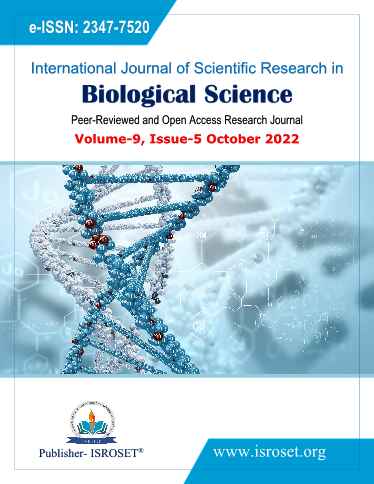Microbiological and Physico-Chemical Analysis in Potable Water from Different Sources via Elite Regions of Meghalaya, India
Keywords:
Escherichia.coli, Coliforms, Waterborne, bacteria, Yeast and Mould, Physicochemical parameters, water quality, Public Health Engineering-PHE water supplyAbstract
Introduction: Quality of drinking water is one of the major concern in the Globe. Drinking water should be free from pathogens and within limit of physico chemical parameters such as pH, chloride, alkalinity etc., for preventing diseases and improving quality of life.
Objectives: Assessment of water quality on the basis of microbiological and physico-chemical properties from different sources of water from selected regions of Meghalaya i.e., from stream, spring, groundwater, well water, PHE UV treated water and drill water(raw).
Study Design: This study was conducted on six different samples from stream, spring, groundwater, well water, PHE UV treated water and drill water(raw) respectively at State Food testing laboratory, Meghalaya which is accredited by National Board for Testing and Calibration Laboratories (NABL- A constituent board of Quality Council of India).
Methods: Microbiological methods include IS 15185:2002 for detection of E.coli, IS 5402:2012 method for detection of Standard Plate Count and IS 5403:1999 for detection of Yeast and mould and basic physicochemical methods from FSSAI manual for detection of pH, Total hardness, total alkalinity, Calcium magnesium, chloride and samples appearance.
Results: In this study; it was observe that PHE UV treated water depicts absence of bacterial & fungal growth, also passes physio-chemical parameters as per IS:10500.
Conclusion: On microbiological & physicochemical analysis, it was found that PHE UV treated water is the only source of water fit for consumption.
References
]es of matter. Academic Press, pp 435-468,2014
Völker S, Kistemann T. The impact of blue space on human health and well-being–Salutogenetic health effects of inland surface waters: A review. International journal of hygiene and environmental health. Vol.214, issue 6, pp.449-60,2011.
Martinez JL. The role of natural environments in the evolution of resistance traits in pathogenic bacteria. Proceedings of the Royal Society B: Biological Sciences, vol. 22, issue1667, pp 2521-30, 2009.
Pal P. Detection of coliforms in drinking water and its effect on human health-A review. International Letters of Natural Sciences. Vol.12, issue 2, pp 40-48,2014.
Paruch AM, Mæhlum T. Specific features of Escherichia coli that distinguish it from coliform and thermotolerant coliform bacteria and define it as the most accurate indicator of faecal contamination in the environment. Ecological Indicators. Vol 23 issue 1,pp,140-142,2012.
Subba Rao, C. and N.V. Subba Rao: Ground water quality in residential colony. Ind. J. Environ. Hlth., Vol.37,Issue 4, pp.295-300,1995.
Novak Babi? M, Gostin?ar C, Gunde-Cimerman N. Microorganisms populating the water-related indoor biome. Applied Microbiology and Biotechnology.Vol.104,Issue 15, pp.6443-62,2020.
Singh R, Kashyap S, Pandey A. Water quality and human health. InClimate Impacts on Water Resources in India,pp. 331-369, 2021.
Antony, R. M., & Renuga, F. B. Microbiological analysis of drinking water quality of Ananthanar channel of Kanyakumari district, Tamil Nadu, India. Revista Ambiente & Água, Vol.7,No.1, pp.42-48,2012
Prasai, Tista, et al. "Microbiological analysis of drinking water of Kathmandu Valley." Scientific world Vol.5,Issue 5,pp. 112-114,2007.
FSSAI manual https://www.fssai.gov.in/upload/uploadfiles/files/WATER.pdf,Vol.2,18th Edition.
El-Dessouky HT, Ettouney HM. Fundamentals of salt water desalination. Elsevier; Vol 1. issue 1, pp. 1-6,2002
Bej AK, Steffan RJ, DiCesare J, Haff L, Atlas RM. Detection of coliform bacteria in water by polymerase chain reaction and gene probes. Applied Environmental Microbiology.Vol.56,pp.307–314,1990
Petit, J. R. et al. Paleoclimatological implications of the Vostok core dust record. Nature Vol.343,pp.56– 58,1990.
B.M. Kudryavtseva, An experimental approach to the establishment of zones of hygienic protection of underground water sources on the basis of sanitary-bacteriological indices. J. Hyg. Epidemiol. Microbiol. Immunol 18 pp 503-511.1972
S.C. Edberg, M.J. Allen, and D.B. Smith, Defined substrate technology method for rapid and specific simultaneous enumeration of total coliforms and Escherichia coli from water: collaborative study, J. Assoc. Analy. Chem, Vol.74, pp 526-529,1991
BHUPALWAR SR, PATHAN AV. Physico-Chemical Parameters of Godavari River Waters and The Freshwater Pulmonate I. exustus. Ashok Yakkaldevi; pp.112-118, 2020.
Kumari dm. Studies on physicochemical parameters to assess the ground water quality for drinking purpose in ballia district. International Journal of Advanced Research in Multidisciplinary Sciences eISSN 2581-8996. Vol. 15,issue.2,pp.33-8, 2019.
Downloads
Published
How to Cite
Issue
Section
License

This work is licensed under a Creative Commons Attribution 4.0 International License.
Authors contributing to this journal agree to publish their articles under the Creative Commons Attribution 4.0 International License, allowing third parties to share their work (copy, distribute, transmit) and to adapt it, under the condition that the authors are given credit and that in the event of reuse or distribution, the terms of this license are made clear.







